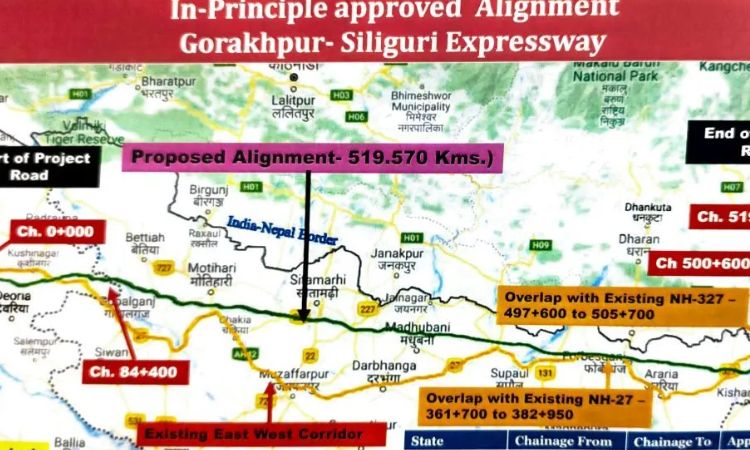Gorakhpur Siliguri Expressway – Complete Details
Gorakhpur Siliguri Expressway is an important infrastructure project that goes through in Uttar Pradesh by connecting Siliguri in West Bengal. The Total length of this highway is 520 kilometers. It aims to improve the journey in the East India and reduce long-distance connections.
The expressway is being developed at an estimated cost of 32,000 crore and will be run by the National Highway Authority (NHAI). It is designed to reduce travel time, promote business, and open new routes for transport and logistics. The development is scheduled for completion by the year 2028.
Also Read- Ganga Expressway
About Gorakhpur Siliguri Expressway
Gorakhpur Siliguri Expressway is an important upcoming road project that will connect Gorakhpur in Uttar Pradesh to Siliguri in West Bengal.
The purpose of this highway is to travel through the large parts of Bihar, and to travel between the north and northeast India very easily and speedily. When completed, it will not only reduce travel time but will also improve transport, trade, and connections throughout the region.
The National Highway Authority of India (NHAI) introduced the project in 2021, with its completion targeted for 2028. The responsibility for preparing a detailed project report (DPR) is given to LN Malviya Infra Project’s private team. A Bhopal-based company Limited. The highway will span approximately 520 kilometers, with an estimated budget of nearly ₹32,000 crore.
The expressway will pass through 10 districts in three states. In Uttar Pradesh, it will cover Gorakhpur and Deoria. In Bihar, it passes through Gopalganj, Sitamarhi, Darbhanga, Madhubani, and Kishanganj. In Western Bengal, the Route Nord -Dinajpur, Darjeeling, and Jalpaiguri are included.
The expressway is expected to promote local economies a major boost, improve the road infrastructure, and support real estate development along the way. This transport of goods will also make it fast and smooth. Overall, there is a project that promises long-term development for the entire eastern part of India.
Key Highlights of Gorakhpur–Siliguri Expressway
| Project Name | Gorakhpur Siliguri Expressway |
| Proposed By | National Highways Authority of India (NHAI) |
| Year Proposed | 2021 |
| Expected Completion | 2028 |
| Total Length | Approx. 520 kilometers |
| Estimated Cost | ₹32,000 crore |
| Number of States Covered | 3 (Uttar Pradesh, Bihar, West Bengal) |
| Number of Districts | 10 |
| Districts in U.P. | Gorakhpur, Deoria |
| Districts in Bihar | Gopalganj, Sitamarhi, Darbhanga, Madhubani, Kishanganj |
| Districts in West Bengal | Uttar Dinajpur, Darjeeling, Jalpaiguri |
| DPR Consultant | LN Malviya Infra Projects Pvt. Ltd., Bhopal |
| Main Purpose | Improve connectivity, reduce travel time, boost trade |
Gorakhpur Siliguri Expressway: Route Map

The Gorakhpur Siliguri Expressway stands as one of India’s most important infrastructure initiatives. This upcoming highway will connect Gorakhpur in Uttar Pradesh to Siliguri in West Bengal, which will be more than 519 km. The four-lane access-controlled road was designed, and it also has a six-lane provision for future expansion..
The route will pass through important districts like Deoria, Kushinagar, Gopalganj, Darbhanga, and Kishanganj, offering faster and smoother connectivity across Uttar Pradesh, Bihar, and West Bengal. Once completed, this expressway will cut down the current travel time of 14 to 15 hours to just 8 to 9 hours.
This project is a game-changer for both logistics and tourism, as it will open up new economic opportunities for the entire region. It will also connect to major roads and highways, making transportation more efficient for both goods and people.
Work on the expressway is progressing in phases, and the target for completion is set around 2028. Once operational, it will boost regional growth and make travel between North and Northeast India faster and more convenient than ever before.
Also Read – Delhi Mumbai Expressway
Route Details and Map – Gorakhpur–Siliguri Expressway
| Detail | Description |
| Starting Point | • Gorakhpur, Uttar Pradesh |
| Ending Point | • Siliguri, West Bengal |
| Total Distance | • Around 520 kilometers |
| States Covered | • Uttar Pradesh • Bihar • West Bengal |
| Districts in U.P. | • Gorakhpur • Deoria |
| Districts in Bihar | • Gopalganj • Sitamarhi • Darbhanga • Madhubani • Kishanganj |
| Districts in W.B. | • Uttar Dinajpur • Darjeeling • Jalpaiguri |
| Main Purpose | • Reduce travel time • Improve connectivity • Boost regional development |
Project Timeline and Current Status Gorakhpur Siliguri Expressway
1. When was the project proposed?
- The National Highway Authority of India (NHAI) put forward the expressway plan in 2021.
- It is part of a nationwide road development scheme, Bharatmala Pariyojana, a nationwide road development plan
2. Who is preparing the DPR?
- A Detailed Project Report (DPR) is prepared by LN Malviya Infra Projects PVT. Ltd., a company located in Bhopal.
- DPR includes root planning, technical studies, and land details
3. The current project phase
- The project is currently in the planning and land collection phase.
- Investigation work and approval continue before construction begins.
4. Total costs for the project
- The estimated budget for the project is around 32,000 crore.
- This covers land acquisition, construction work, and overall project planning.
5. Required perfection year
- If things are used, the highway will probably be completed by 2028.
- This will be an important route to connect to the North and North India
Importance and Benefits of Gorakhpur Siliguri Expressway
The Gorakhpur Siliguri Expressway is more than just a highway – it’s a transformation project to promote development in East India.. Once completed, it will make travel between Uttar Pradesh, Bihar, and West Bengal faster and smoother.
More than that, it will open new doors for business, boost trade, and connect areas that earlier had poor road access. This expressway is expected to improve local economies, reduce transportation costs, and give a major push to logistics and infrastructure growth. Here’s a breakdown of its major benefits:
1. Fast travel time
- Travel between Gorakhpur and Siliguri will be faster and more comfortable.
- The long road trip that was once for hours will be cut a lot.
- This will reduce the amount of the old, overloaded highways in the region.
2. Economic Growth
- Better road access will encourage investment in nearby towns and districts.
- Local industries and small businesses will grow due to improved transport.
- Job opportunities may rise as the region becomes more connected
3. Promote local trade and connections
- It will be easy to transfer goods to farmers, traders, and local suppliers.
- The external areas will be better connected to large markets and cities.
- It will also improve access to schools, hospitals, and public services.
4. Impact on Freight and Logistics
- Expressway will be an important route for trucks and cargo vehicles.
- Transport of goods between North and Northeast India will be faster and cheaper.
- This will reduce the use of fuel, distribution delays, and logistics costs for companies
Impact on Real Estate and Infrastructure

The Gorakhpur Siliguri Expressway is expected to do more than just improve roads — it will change the way people live and invest in the areas along its route. With faster travel and better connectivity, many nearby towns and rural areas will become more active and desirable.
New business centers may come up, and people from other cities might look to invest in land or property near the highway. All of this will increase the value of the land and create more job options for locals. Here’s how the expressway will impact real estate and infrastructure:
1. Which Areas May Become Hot for Property Investment
- Demand for land will be seen in cities and villages near the highway.
- Areas in districts such as Deoria, Sitamarhi, Darbhanga, and Kishanganj can attract the interest of property.
- Investors can look for plots, shops, and land along the route for future development
2. New Job and Business Opportunities
- As construction and road access improve, new businesses such as hotels, shops, and service stations can open.
- Local youth can get more work in transport, trade, and retail.
- Small towns can gradually turn into a commercial hub due to better road connections
3. Land Value Appreciation Near the Route
- Land close to the Expressway is possibly to become more valuable over time.
- Property prices may also increase as connectivity improves and demand increases.
- Early buyers and landowners may gain the maximum as the improvement choices up.
Challenges and Concerns
While the Gorakhpur Siliguri Expressway guarantees a variety of improvements and smoother connectivity, massive tasks like this often come with some roadblocks.
From obtaining huge stretches of land to coping with environmental influences and securing enough funding, several demanding situations could sluggish down progress.
These issues need proper attention and plans to ensure the expressway is built easily and safely. Here are some key concerns related to the challenge:
1. Land Acquisition Issues
- Getting land from farmers and local landowners may cause delays.
- Some people might not be willing to sell or may ask for higher compensation.
- Legal disputes or missing land documents in rural areas can make the process more difficult
2. Environmental and Displacement Concerns
- The expressway may cut through villages, farmland, and green zones, affecting the local environment.
- Some families may have to relocate, which could lead to resistance or unhappiness among locals.
- Forest clearance and environmental studies may delay official project approvals
3. Funding Challenges
- With a total cost of ₹32,000 crore, arranging funds on time is a big responsibility.
- Delays in government approvals or budget cuts can slow down construction work.
- Ensuring timely payments to contractors and workers is crucial for smooth progress
Conclusion
Gorakhpur Siliguri Expressway is not just a highway – it’s a big step towards improving the connection in the East India. By adding Uttar Pradesh, Bihar, and West Bengal, it will reduce the time for the journey and reduce the transport between the north and northeast India.
The project is expected to open new financial opportunities, promote local businesses, and improve access to important services in remote areas. It will also support the development of cities nearby, making them a potential hotspot for real estate development and employment generation.
Although the project is still in its early stages and faces challenges such as the acquisition of land and money, its long-term effects are expected to be very positive.
When completed, this highway will not only save time but will also serve areas that have long been underserved. In fact, it is a project that can change the future of connection and development in East India
FAQ( Frequently Asked Questions)
1. Is the Siliguri Gorakhpur Expressway open?
No, it’s under construction and expected to open by 2028.
2. What is the length of the Gorakhpur Siliguri Expressway?
Around 520 km.
3. The Expressway will pass through which areas in Bihar?
Gopalganj, Sitamarhi, Darbhanga, Madhubani, Kishanganj, East & West Champaran, Sheohar, Supaul, Araria, Forbesganj.
4. How long will it take to reach Siliguri via the Expressway?
Around 6 to 9 hours

